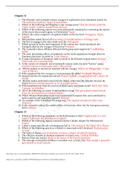Exam (elaborations)
APHIST: Chapters 22 to 28 Test Yourself - All questions and Answers
- Course
- Fundamentals of Nursing
- Institution
- Thompson River University (TRU )
Chapter 22 1. The fifteenth- and sixteenth-century voyages of exploration were stimulated mainly by: The individual explorers’ hopes of enrichment 2. Which of the following did Magellan’s epic voyage prove? That the islands called the “Spice Lands” could be reached from the East 3. Which...
[Show more]




